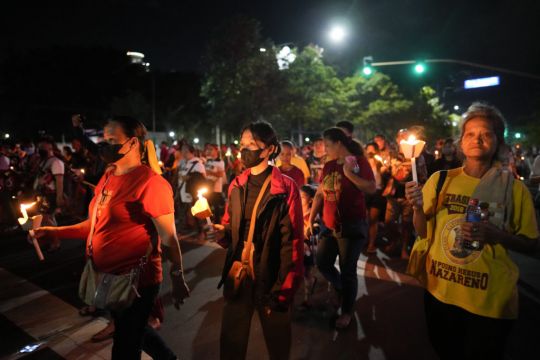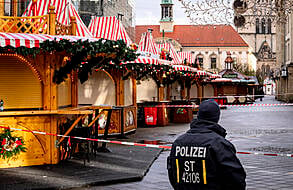Thousands of Catholics have joined a night procession through Manila to venerate a centuries-old charred statue of Jesus Christ, which was not included in the parade to discourage an even larger crowd amid lingering fears over coronavirus.
The 80,000 devotees, many wearing protective masks, joined the 3.7-mile “Walk of Faith” in the Filipino capital, but that was a fraction of the more than one million worshippers who typically converged in pre-pandemic years to pay homage to the life-size Black Nazarene statue in one of Asia’s biggest religious festivals.
In chaotic dawn-to-midnight processions in the past, when the Black Nazarene was paraded on a carriage pulled by ropes, mobs of mostly poor, barefoot devotees in maroon shirts would squeeze their way through the crowd around the slow-moving carriage to throw towels at volunteers, who wiped parts of the statue in the belief that the Nazarene’s powers would cure ailments and ensure good health and a better life.

Without the Nazarene, Sunday’s procession from a historic park by Manila Bay to a church in Quiapo district was orderly but still intense, with many worshippers mumbling prayers and others singing and chanting “Nazareno” as they marched in the early hours of the morning. Many carried replicas of the religious icon.
The procession, which kicked off after a midnight Mass, was completed in less than three hours.
Officials of the church in Quiapo, where the Nazarene is enshrined throughout the year, brought the statue to a grandstand at Rizal Park before Sunday’s procession to allow worshippers to pray before it through the weekend up to Monday, when the annual feast of the Black Nazarene is celebrated. Kissing the statue was prohibited due to fears the action could spread Covid-19.

Teresa Pateane, 51, carried a Nazarene replica but she said the religious gathering was not the same without the mystical statue amid a sea of worshippers jostling to touch it in a show of piety.
“We are sad because we cannot do the things we used to do, like climbing up the carriage,” she said. “But we are very thankful that the (Black Nazarene) is already on the grandstand. The people can see it again.”
The religious Nazarene procession was suspended at the height of Covid outbreaks in the last two years in the Philippines, one of the south-east Asian countries hardest-hit by the pandemic.
Church officials decided not to parade the Nazarene this year as a precaution, even after the pandemic eased, but organised the religious march as an alternative at a time of widespread social and economic distress.

Police were on alert and deployed thousands of personnel to secure the country’s largest gathering and remind devotees not to congregate too closely for health reasons.
The Nazarene statue is believed to have been brought from Mexico to Manila on a galleon in 1606 by Spanish missionaries. The ship that carried it caught fire, but the charred statue survived.
Many devotees believe the statue’s endurance, from fires and earthquakes through the centuries and intense bombings during the Second World War, is a testament to its miraculous powers.
The spectacle reflects the unique brand of Catholicism, which includes folk superstitions, in Asia’s largest Catholic nation. Dozens of Filipinos have themselves nailed to crosses on Good Friday in another unusual tradition to emulate Christ’s suffering that draws huge crowds of worshippers and tourists each year.







